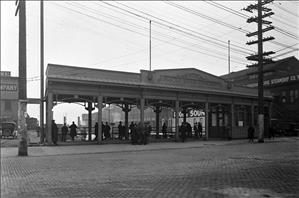On October 30, 1978, the Committee of 33 is officially incorporated under Washington law as a 501-C nonprofit organization. First established in the 1960s, the elite organization of women, whose membership never exceeds 33, dedicates itself to enhancing Seattle's beauty. Even before incorporating it has helped fund projects including downtown tree-planting and restoration of the Washington Street Public Boat Landing Facility, and in the decades after doing so it will continue to support arts and heritage projects throughout the city. The committee shuns publicity, choosing only to place its logo on completed projects.
A Rough Start
In 1960 a group of women led by Anne Gould Hauberg (b. 1917), Jacquetta Blanchett (1906-1998), and Anne Robinson formed the first Committee of 33 to encourage the beautification of Seattle and to promote the arts. Early meetings were chaotic, and with no idea of how to proceed, the group soon collapsed under its own weight.
Not wanting to abandon the concept, the founders and some of the original members re-formed the organization in 1968 under a stronger set of rules. A steering committee was created to move the group forward in an organized manner. Meetings were held monthly, with members taking turns hosting.
At the reconstituted committee's first meeting on May 1, 1968, membership stood at 19. Later members were admitted by secret ballot and a unanimous favorable vote was required for their acceptance. At no point was the total number of members allowed to exceed 33. The committee formally incorporated as a Washington non-profit in 1978.
A Group of Congenial People
As defined in the minutes of its first meeting, the Committee of 33 was "a group of congenial people who love their city and wish to enhance it in a meaningful way" (Committee of 33 Records). The committee sought out projects for which it could provide seed money and then urge city officials to take a more positive role in city enhancement. Some projects took years to complete, while the committee researched, planned, and raised money to achieve its goals.
The Committee of 33's first project involved restoration of the Prefontaine Place Fountain, for which it donated $3937.70. The first phase of the project was completed in 1970 using those funds. Two years later, the committee donated $5,739.90 for tree plantings along Occidental Avenue in Pioneer Square.
The committee next set its sights on the former Naval Shore Station, located on Seattle's waterfront near Pioneer Square at the foot of Washington Street, which had deteriorated badly since its opening in 1920. The committee's $4292.14 donation for improvements to the wrought-iron pergola spurred others to help the cause, and the newly restored and renamed Washington Street Public Boat Landing Facility was added to the National Register of Historic Places in 1974.
City Enhancements
Other early projects included new sconces in the Seattle Center Opera House, which were installed in 1977; additional outlets for the Seattle Center International Fountain in 1979, and trees planted along Westlake Boulevard in 1980. The committee donated $9149.89 for the purchase of a Haida totem pole in 1981, and then spent $27,292.72 for its restoration and installation along the Montlake Ship Canal. In 2013, when the pole, carved in 1937 by Haida Chief John Dewey Wallace and called Story of North Island, needed additional restoration, the committee again provided a donation for that purpose.
As the Committee of 33 grew stronger, members often invited outside speakers to their meetings, which helped them decide where they could lend support. This forum of city officials, arts advocates, and heritage experts proved to be invaluable to the organization in developing its projects.
In the 1990s, the Committee of 33 helped to fund landscaping at Lake Union Park and also to place banners at the Burke Museum and Seattle Art Museum. Well into the twenty-first century, the committee continued to support arts and heritage projects throughout the city, with little or no fanfare.

